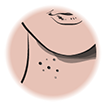Condition
Benign Skin Lesion
A benign skin lesion is a non-cancerous skin abnormality or growth that can appear anywhere on the body. In most cases, these lesions are not harmful and may not require treatment unless they lead to symptoms like discomfort or itching.
Types of Benign Skin Lesion

Seborrheic
Keratosis

Skin Tags

Cherry
Angioma

Solar
Lentigo

Sebaceous
Hyperplasia

Syringoma

Milia

Xanthelasma
What causes it
What causes Benign Skin Lesion?
Seborrheic Keratosis
Seborrheic Keratosis is a common benign skin condition. It has a waxy, scaly, and raised appearance, typically appearing in shades of black or brown. It can occur on areas of the body such as the face, chest, shoulders, and back. The exact cause of seborrheic keratosis is not fully understood.
Skin Tags
Skin tags are soft, flesh-colored, pedunculated benign growths commonly found in skin folds such as the eyelids, neck, armpits, and groin area. The exact cause of skin tags is not fully understood.
Cherry Angioma
Cherry angiomas (red moles) contain blood vessels, which give them their red color. They can appear on any part of the body, commonly on the face and chest. The exact cause of cherry angiomas is not fully understood. However, research has suggested that factors such as aging, pregnancy (hormonal changes), and genetics may contribute to their appearance
Solar Lentigo
Solar lentigo (age spot) is a flat, hyperpigmented patch on the skin often linked to sun exposure. When skin is exposed to the sun for extended periods, melanin can accumulate, leading to brown discoloration. Solar lentigo is more commonly seen in individuals with fair skin as they age.
Sebaceous Hyperplasia
Sebaceous (oil) hyperplasia occurs when the sebaceous glands become overactive and produce excess oil, which can become trapped under the skin. While this condition can affect any area of the body, it is more commonly seen on the facial skin.
Syringoma
Syringoma occurs due to the overgrowth of cells from sweat glands (eccrine glands). It typically appears as small, firm, flesh-colored to yellowish bumps in clusters on the skin. Syringomas are most commonly found on the upper cheeks, lower eyelids, armpits, chest, and genital area.
Milia
Milia develop when dead skin cells become trapped under the surface of the skin instead of shedding properly. This can also occur due to skin damage from blisters, injuries, burns, sun exposure, or long-term use of steroid creams. Milia often appear as small, white bumps in clusters on the eyelids, nose, and cheeks.
Xanthelasma
Xanthelasma is a soft, yellowish, fatty deposit that forms under the skin and is often linked to high blood cholesterol levels. It is more frequently seen in women and individuals with a family history from regions such as Asia or the Mediterranean.
Removal is absolutely an option for benign skin lesions, especially if it is causing pain, irritation, discomfort or even for cosmetic reasons. Removal technique must have excellent clinical efficacy and favourable cosmetic outcomes.

Treatment Options
BSL Removal is a procedure that uses heat from a mild electric current to remove non-cancerous skin lesions or abnormal growths from various areas of the body. The heat causes the targeted area to dry out and eventually shed. The skin then heals and new tissue forms over the area.
Similar Conditions
From around the age of 25, the first signs of skin changes may start to appear and become noticeable. Over time, the skin may lose some of its earlier smoothness and fullness.
Skin pigmentation disorders affect the color of the skin and can result from excess melanin production. They may appear in small patches, cover larger areas, or involve the entire body.
Schedule A Consultation
Being results driven, GEM Clinic provides consultations personally by our doctors to assess client's concerns. Our doctors will determine the best suited treatment to deliver the most optimal results for you!